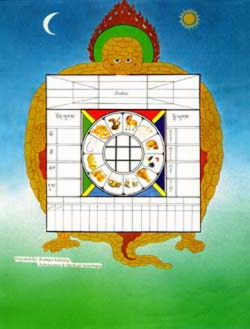Difference between revisions of "Lunar age calculation"
m (Text replacement - "old" to "old") |
|||
| Line 1: | Line 1: | ||
[[File:Sipaho.jpg|thumb|250px|]] | [[File:Sipaho.jpg|thumb|250px|]] | ||
| − | The [[traditional]] lunar age calculation operates with "[[void]] years" (xusui 虛歲). This method uses calendric years to indicate the age of a [[person]]. When born, a [[person]] is one "year" (sui 歲) | + | The [[traditional]] lunar age calculation operates with "[[void]] years" (xusui 虛歲). This method uses calendric years to indicate the age of a [[person]]. When born, a [[person]] is one "year" (sui 歲) old, not because he or she has spent 9 months in the [[womb]] of the mother, but because the current year is the first calendric year the [[person]] [[experiences]]. With the shift to the next calendric year (according to the {{Wiki|Chinese}} [[calendar]]), the [[person]] in question is two "years" (sui) old, even if he or she was born only a week before the {{Wiki|Chinese}} New Year. The consequence is that the [[difference]] between the lunar age and the {{Wiki|real}} age (shisui 實歲, measured in [[absolute]] [[time]]) can be as much as one, in many cases even two "years". A [[person]] in a [[traditional]] text, having the age of 20 sui, is thus 19 or 18 years ([[absolute]]) old. |
{{R}} | {{R}} | ||
[http://www.chinaknowledge.de/History/Terms/sui.html www.chinaknowledge.de] | [http://www.chinaknowledge.de/History/Terms/sui.html www.chinaknowledge.de] | ||
[[Category:Buddhist Terms]] | [[Category:Buddhist Terms]] | ||
[[Category:Astrology]] | [[Category:Astrology]] | ||
Latest revision as of 04:42, 12 September 2013
The traditional lunar age calculation operates with "void years" (xusui 虛歲). This method uses calendric years to indicate the age of a person. When born, a person is one "year" (sui 歲) old, not because he or she has spent 9 months in the womb of the mother, but because the current year is the first calendric year the person experiences. With the shift to the next calendric year (according to the Chinese calendar), the person in question is two "years" (sui) old, even if he or she was born only a week before the Chinese New Year. The consequence is that the difference between the lunar age and the real age (shisui 實歲, measured in absolute time) can be as much as one, in many cases even two "years". A person in a traditional text, having the age of 20 sui, is thus 19 or 18 years (absolute) old.
